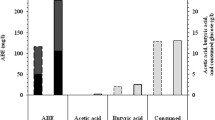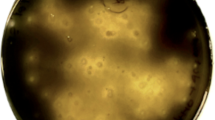Abstract
Anaerobic enrichments with methoxylated aromatic compounds as substrates (vanillate, syringate, trimethoxycinnamate) were inoculated from freshwater mud and sewage sludge samples. In 12 out of 16 cultures the same type of rod-shaped, motile bacteria was selectively enriched. Two strains, NZva16 and NZva24, were isolated in pure culture and recognized as Acetobacterium woodii by comparison with the type strain (DSM 1030).
All three Acetobacterium strains were able to grow with all 10 of the tested aromatic compounds containing methoxyl groups. In the presence of bicarbonate, these substrates were used as sole organic electron donors and carbon sources. UV-absorption spectra revealed that the aromatic rings were not degraded, and that the corresponding hydroxy derivatives of the methoxylated compounds were formed. The only further fermentation product formed was acetate. When equimolar concentrations of the methoxylated benzoic acid derivatives were applied, the growth yields were proportional to the number of methoxyl groups per molecule. Methoxyl groups or methanol were metabolized by homoacetate fermentation: in the presence of bicarbonate 4 mol of acetate. In case of the methoxylated cinnamic acid derivatives less acetate was formed and the corresponding hydroxy derivatives of phenylpropionic acid appeared as a result of the double bond reduction in the acrylate side chain. In comparison to the benzoate derivatives with the same number of methoxyl groups, higher growth yields were obtained with the cinnamate derivatives.
Similar content being viewed by others
References
Axelrod J, Daly J (1968) Phenol-O-methyltransferase. Biochim Biophys Acta 159:472–478
Balch WE, Schobert S, Tanner RS, Wolfe RS (1977) Acetobacterium, a new genus of hydrogen-oxidizing, carbon dioxide-reducing, anaerobic bacteria. Int J Syst Bacteriol 27:355–361
Bernhardt F-H, Staudinger H, Ullrich V (1970) Eigenschaften einer p-Anisat-O-Demethylase im zellfreien Extrakt von Pseudomonas species. Hoppe-Seyler's Z Physiol. Chem. 351:467–478
Biebl H, Pfennig N (1978) Growth yields of green sulfur bacteria in mixed cultures with sulfur and sulfate reducing bacteria. Arch Microbiol 117:9–16
Braun K (1979) Untersuchungen zum autotrophen, heterotrophen und mixotrophen Wachstrum von Acetobacterium woodii und Clostridium aceticum. Thesis, Univ. Göttingen
Braun M (1981) Charakterisierung von anaeroben autotrophen Essigsäurebildnern und Untersuchungen zur Essigsäurebildung aus Wasserstoff und Kohlendioxid durch Clostridium aceticum. Thesis, Univ. Göttingen
Cartwright NJ, Buswell JA (1967) The separation of vanillinate O-demethylase from protocatechuate 3,4-oxygenase by ultracentrifugation. Biochem J 105:767–770
Cartwright NJ, Smith ARW (1967) Bacterial attack on phenolic ethers. Biochem J 102:826–841
Hamlett NV, Blaylock BA (1969) Synthesis of acetate from methanol. Bacteriol Proc, p 207
Healy JB Jr, Young LY (1979) Anaerobic biodegradation of eleven aromatic compounds to methane. Appl Environ Microbiol 38:84–89
Imhoff D (1981) Clostridium barkeri: Selen-abhängiger Nikotinsäure-und Purinabbau sowie taxonomische Neueinordnung. Thesis, Univ Göttingen
Laanbroek HJ, Pfennig N (1981) Oxidation of short-chain fatty acids by sulfate-reducing bacteria in freshwater and in marine sediments. Arch Microbiol 128:330–335
Pfennig N (1978) Rhodocyclus purpureus gen. nov. and sp. nov., a ring-shaped, vitamin B12-requiring member of the family Rhodospirillaceace. Int J Syst Bacteriol 28:283–288
Smith MR, Mah RA (1978) Growth and methanogenesis by Methanosarcina Strain 227 on acetate and methanoll. Appl Environ Microbiol 36:870–879
Trüper HG, Schlegel HG (1964) Sulphur metabolism in Thiorhodaceae. I. Quantitative measurements of growing cells of Chromatium okenii. Antonie van Leeuwenhoek J Microbiol Serol 30:225–238
Widdel F (1980) Anaerober Abbau von Fettsäuren und Benzoesäure durch neu isolierte Arten Sulfat-reduzierender Bakterien. Thesis, Univ Göttingen
Zeikus JG, Lynd LH, Thompson TE, Krzycki JA, Weimer PJ, Hegge PW (1980) Isolation and characterization of a new, methylotrophic, acidogenic anaerobe, the Marburg strain. Curr Microbiol 3:381–386
Author information
Authors and Affiliations
Rights and permissions
About this article
Cite this article
Bache, R., Pfennig, N. Selective isolation of Acetobacterium woodii on methoxylated aromatic acids and determination of growth yields. Arch. Microbiol. 130, 255–261 (1981). https://doi.org/10.1007/BF00459530
Received:
Issue Date:
DOI: https://doi.org/10.1007/BF00459530




